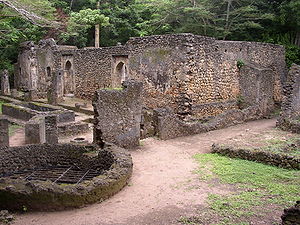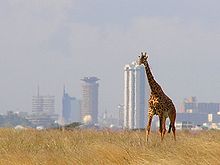|
|
|
| |
| |
| |
 |
About Kenya |
|
|
| |
The Republic of Kenya is a country in East Africa. Lying along the Indian Ocean, at the equator, Kenya is bordered by Ethiopia (north), Somalia (northeast), Tanzania (south), Uganda plus Lake Victoria (west), and Sudan (northwest). The capital city is Nairobi. The population has grown rapidly in recent decades to nearly 38 million. Kenya has numerous wildlife reserves, containing thousands of animal species.
The country is named after Mount Kenya, a significant landmark and the second among the highest mountain peaks of Africa, and both were originally usually pronounced in English, though the native pronunciation and the one intended by the original transcription Kenia was. During the presidency of Jomo Kenyatta in the 1960s, the current English pronunciation of became widespread because his name retained the native pronunciation. Before 1920, the area now known as Kenya was known as the British East Africa Protectorate and so there was no need to mention mount when referring to the mountain.
Prehistory
Giant crocodile fossils have been discovered in Kenya, dating from the Mesozoic Era, over 200 million years ago. The fossils were found in an excavation conducted by a team from the University of Utah and the National Museums of Kenya in July–August 2004 at Lokitaung Gorge, near Lake Turkana.[9]
Fossils found in East Africa suggest that primates roamed the area more than 20 million years ago. Recent finds near Kenya's Lake Turkana indicate that hominids such as Homo habilis (1.8 and 2.5 million years ago) and Homo erectus (1.8 million to 350 000 years ago) are possible direct ancestors of modern Homo sapiens and lived in Kenya during the Pleistocene epoch. In 1984 one particular discovery made at Lake Turkana by famous palaeoanthropologist Richard Leakey and Kamoya Kimeu was the skeleton of a Turkana boy belonging to Homo erectus from 1.6 million years ago. Previous research on early hominids is particularly identified with Mary Leakey and Louis Leakey, who were responsible for the preliminary archaeological research at Olorgesailie and Hyrax Hill. Later work at the former was undertaken by Glynn Isaac. |
.jpg) |
|
| |
History
The first Christian mission was founded on August 25, 1846, by Dr. Johann Ludwig Krapf, a German sponsored by the Church Missionary Society of England.[10] He established a station among the Mijikenda on the coast. He later translated the Bible into Swahili.
By 1850 European explorers had begun mapping the interior.[11] Three developments encouraged European interest in East Africa in the fist half of the nineteenth century.[12] First, was the emergence of the island of Zanzibar, located off the east coast of Africa.[13] Zanzibar became a base from which trade and exploration of the African mainland could be mounted.[14] By 1840, to protect the interests of the various nationals doing business in Zanzibar, consul offices had been opened by the British, French, Germans and Americans.[15] In 1859, the tonnage of foreign shipping calling at Zanzibar had reached 19,000 tons.[16] By 1879, the tonnage of this shipping had reached 89,000 tons.[17] The second development spurring European interest in Africa was the growing European demand for products of Africa including ivory and cloves.[18] Thirdly, British interest in East Africa was first stimulated by their desire to abolish the slave trade.[19] Later in the century, British interest in East Africa would be stimulated by German competition, and in 1887 the Imperial British East Africa Company, a private concern, leased from Seyyid Said his mainland holdings, a 10-mile (16-km)-wide strip of land along the coast. In 1895 the British government took over and claimed the interior as far west as Lake Naivasha; it set up the East Africa Protectorate. The border was extended to Uganda in 1902, and in 1920 the enlarged protectorate, except for the original coastal strip, which remained a protectorate, became a crown colony. With the beginning of colonial rule in 1895, the Rift Valley and the surrounding Highlands became the enclave of white immigrants engaged in large-scale coffee farming dependent on mostly Kikuyu labor. This area's fertile land has always made it the site of migration and conflict. There were no significant mineral resources—none of the gold or diamonds that attracted so many to South Africa.
Imperial Germany set up a protectorate over the Sultan of Zanzibar's coastal possessions in 1885, followed by the arrival of Sir William Mackinnon's British East Africa Company (BEAC) in 1888, after the company had received a royal charter and concessionary rights to the Kenya coast from the Sultan of Zanzibar for a 50-year period. Incipient imperial rivalry was forestalled when Germany handed its coastal holdings to Britain in 1890, in exchange for German control over the coast of Tanganyika. The colonial takeover met occasionally with some strong local resistance: Waiyaki Wa Henya, a Kikuyu chief who ruled Dagoretti who had signed a treaty with Frederick Lugard of the BEAC, having been subject to considerable harassment, burnt down Lugard's fort in 1890. Waiyaki was abducted two years later by the British and killed.
Following severe financial difficulties of the British East Africa Company, the British government on July 1, 1895 established direct rule through the East African Protectorate, subsequently opening (1902) the fertile highlands to white settlers. |
 |
|
| |
Geography and climate
At 580,367 km2 (224,081 sq mi)[2], Kenya is the world's forty-seventh largest country (after Madagascar). From the coast on the Indian Ocean the Low plains rise to central highlands. The highlands are bisected by the Great Rift Valley; a fertile plateau in the east. The Kenyan Highlands comprise one of the most successful agricultural production regions in Africa. The highlands are the site of the highest point in Kenya (and the second highest in Africa): Mount Kenya, which reaches 5,199 m (17,057 ft) and is also the site of glaciers. Climate varies from tropical along the coast to arid in the interior. Mount Kilimanjaro (5,895 m/19,341 ft) can be seen from Kenya to the South of the Tanzanian border.[39]
Kenya has considerable land area of wildlife habitat, including the Masai Mara, where Blue Wildebeest and other bovids participate in a large scale annual migration. Up to 250,000 blue wildebeest perish each year in the long and arduous movement to find forage in the dry season.[citation needed] The "Big Five" animals of Africa can also be found in Kenya: the lion, leopard, buffalo, rhinoceros and elephant. A significant population of other wild animals, reptiles and birds can be found in the national parks and game reserves in the country. The environment of Kenya is threatened by high population growth and its side effects.[citation needed]
Kenya has a tropical climate. It is hot and humid at the coast, temperate inland and very dry in the north and northeast parts of the country. There is however a lot of rain between March and May, and moderate rain in October and November. The temperature remains high throughout these months.
Kenya is currently facing its worst drought in decades,[40][41] with many crops and much livestock destroyed.[42] The U.N. World Food Program recently said that nearly four million Kenyans urgently |
 |
|
| |
|
| |
|
|
|
|
|
|
|
| |
|